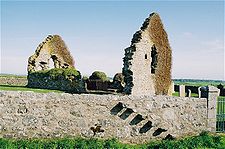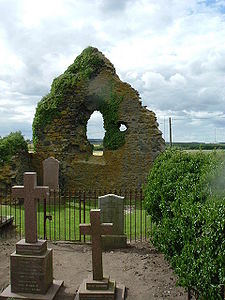
Rattray, Aberdeenshire
Encyclopedia


Earl Marischal
The title of Earl Marischal was created in the peerage of Scotland for William Keith, the Great Marischal of Scotland.The office of "Marischal of Scotland" had been held heritably by the senior member of the Keith family since Hervey de Keith, who held the office of Marischal under Malcolm IV and...
and George Hay, 7th Earl of Erroll
Earl of Erroll
The Earl of Erroll is an ancient title in the Peerage of Scotland. It was created in 1453 for Sir William Hay.The subsidiary titles held by the Earl of Erroll are Lord Hay and Lord Slains , both in the Peerage of Scotland. The Earls of Erroll also hold the hereditary office of Lord High Constable...
". The ancient burgh was located near to Crimond
Crimond
Crimond is a village in the northeast of Scotland, located nine miles northwest of the port of Peterhead and just over two miles from the coast.- Local area :...
, Scotland
Scotland
Scotland is a country that is part of the United Kingdom. Occupying the northern third of the island of Great Britain, it shares a border with England to the south and is bounded by the North Sea to the east, the Atlantic Ocean to the north and west, and the North Channel and Irish Sea to the...
, but the village was largely destroyed and never recovered after a storm in the 18th century that covered it in shifting sands from the nearby dunes at Rattray Head
Rattray Head
Rattray Head is a headland in Buchan, Aberdeenshire, on the north east coast Scotland. To north lies Strathbeg Bay and Rattray Bay is to its south...
. However, there is still a small modern settlement in the area.
The nearby lagoon, Strathbeg Bay (also known as Strathbeg Water or Water of Rattray) had been an "open estuary which was navigable to trading ships" suiting itself to Starny Keppie harbour around which Rattray flourished. However, by 1654, the harbour was silting up badly and was finally cut off when shifting sands during a massive 1720 storm cut off the lagoon to form Loch Strathbeg
Loch Strathbeg
The Loch of Strathbeg is a designated Special Protection Area for wildlife conservation purposes...
, "trapping a small vessel laden with slates", which were subsequently used for the roofs in Crimond and Haddo House.
The harbour was guarded by two of the Nine Castles of Knuckle
The Nine Castles of Knuckle
The Nine Castles of Knuckle are a group of ancient castles found in the extinct area of "Knuckle", which today would be located on the very far corner of the north-east coast of Aberdeenshire in the Buchan area of Scotland.- External links :...
. The Comyn family's Castle of Rattray
Castle of Rattray
The Castle of Rattray was a medieval Scottish castle, with multiple variations on its structure over approximately six centuries. Originally built as a "late 12th- or early 13th century defensive motte" it provided protection for Starny Keppie harbour and Rattray village...
stood on Castlehill (at the time a rock on the coast) on the harbour side and Lonmay Castle on the north shore, of which there are little remains due to quarrying and the site being covered in sand dunes.
Still clearly visible today, the ruined St Mary's Chapel
St Mary's Chapel, Rattray
St Mary's Chapel is a late 12th/early 13th century chapel found in Rattray, Aberdeenshire, Scotland. It was built by William Comyn, jure uxoris Earl of Buchan during the same period as the Castle of Rattray and was "private chapel for the castle" and its residents...
was built as a private place of worship by the Comyn family at the same time as the construction of the Castle of Rattray.
To the west of Rattray on the banks of Loch Strathbeg is the historical site Battle Fauld. The name most likely comes from the "scene of a conflict with the Danes in the time of their later invasions." Indeed, the same source explains that the local dialect and pronunciation (in 1888) used words that "are good Danish or Norwegian" and calls the type of language features used as "thoroughly Norse" to anyone "who knows anything about the Norse family of speech".
The ballad Sir James the Rose
Sir James the Rose
-Synopsis:The broadside opens with the account of Sir James the Rose's love for a lady named Matilda, how her family tried to marry her off, and how he killed her brother for spying on them....
was set in Battle Fauld where he is supposedly buried.

